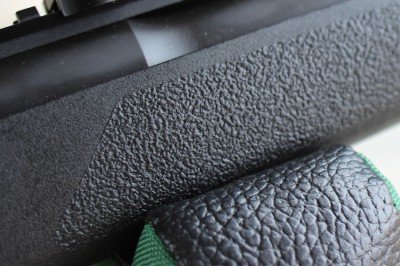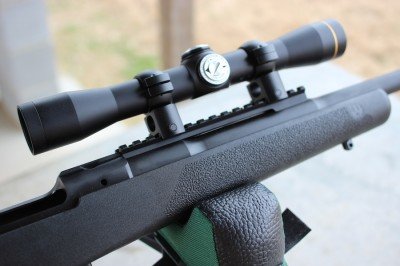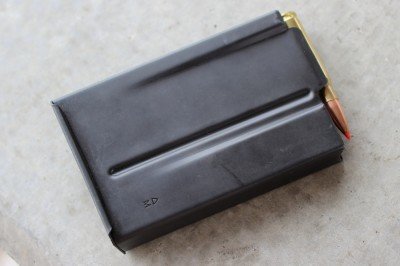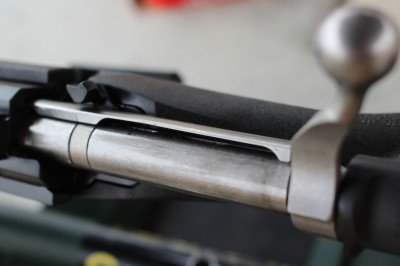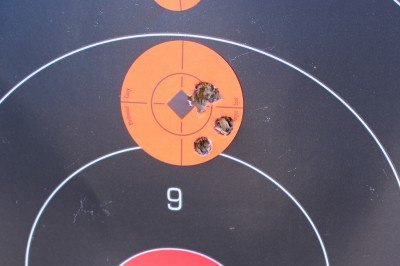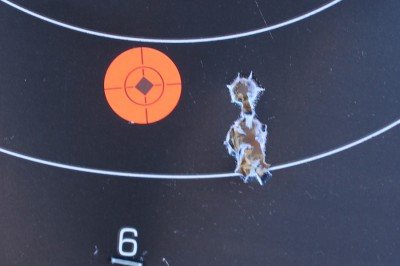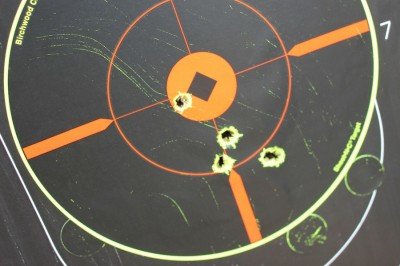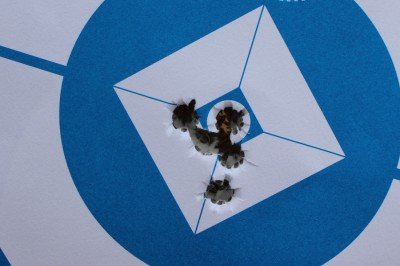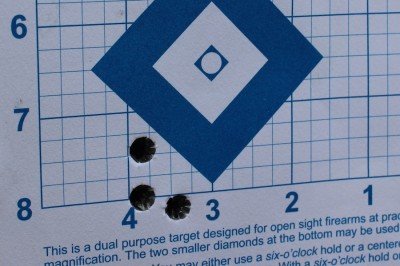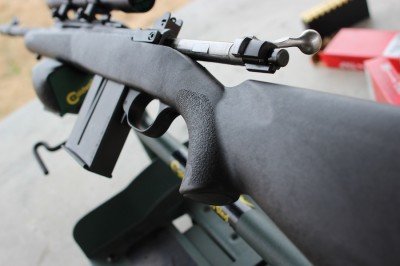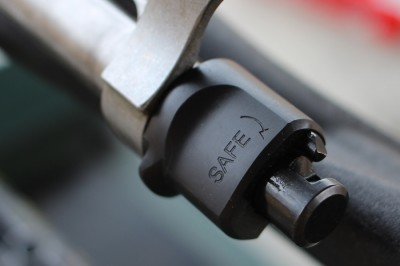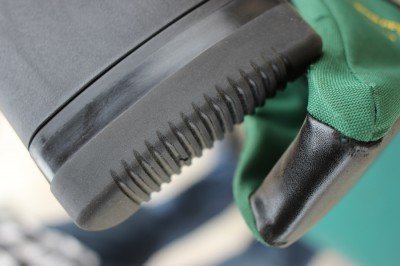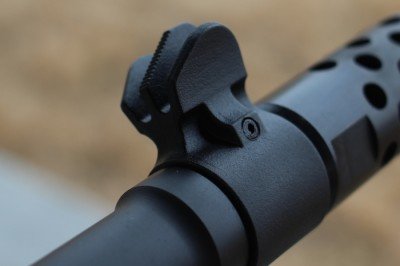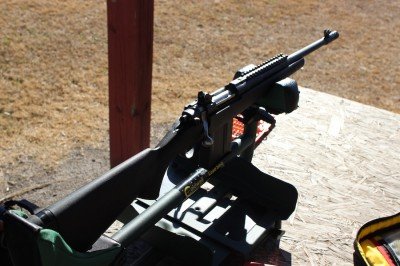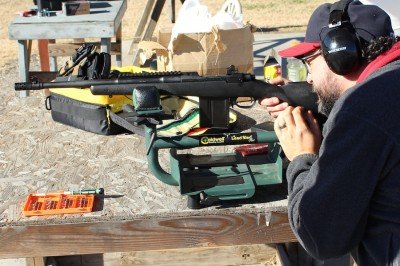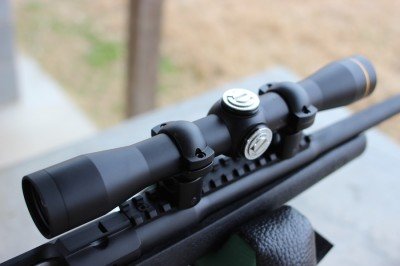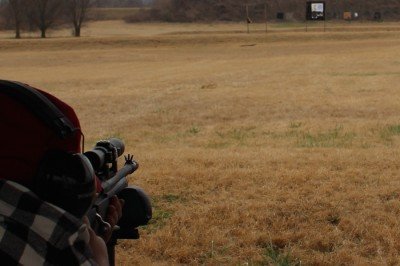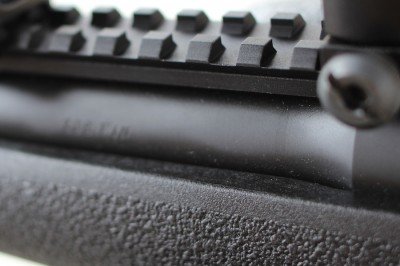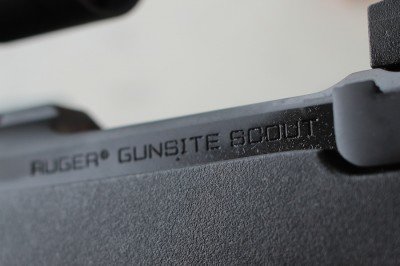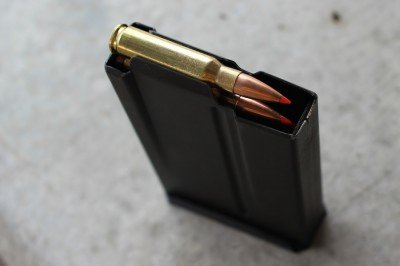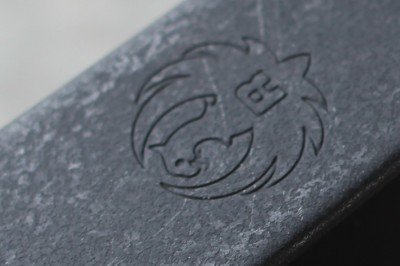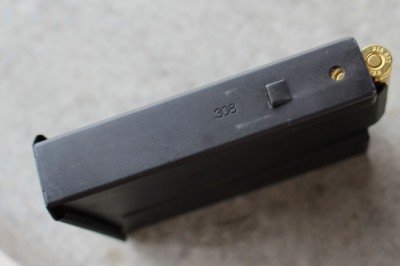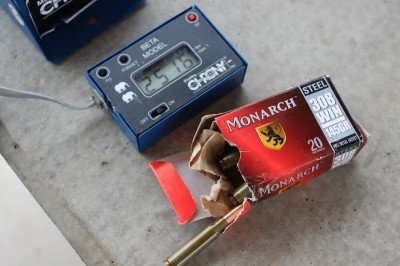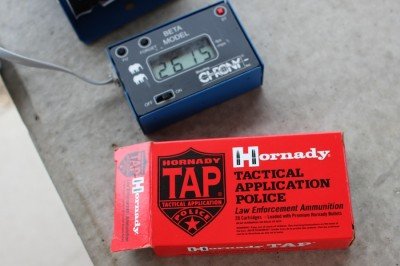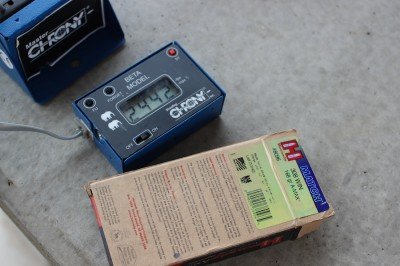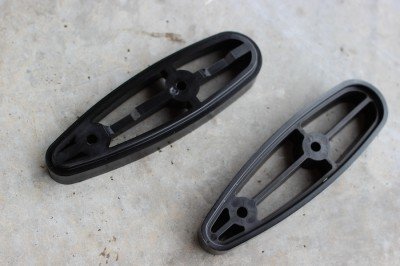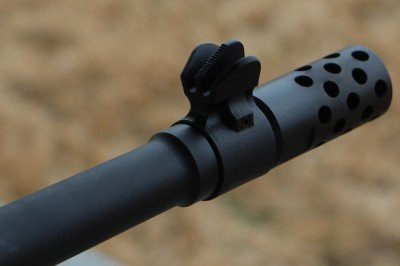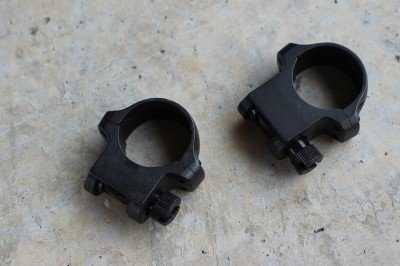[one_half padding=”0 0 0 0px”]
Ruger Gunsite Scout
[/one_half]
[one_half_last padding=”0 0 0 0px”]
[/one_half_last]
Ruger first announced its Gunsite Scout rifle at SHOT Show in 2011. We here at Guns America did a review of it back when it first came out. You can find that here. Since then Ruger has come out with a couple of different versions. This is the newest one, and we got to put it through its paces before it hit the streets, just in time for today’s launch. As you will see below, I am impressed.

This Gunsite, one promoted in some of the early press materials we received, has a matte stainless barrel. Ours was a deep black alloy steel.
The Scout Rifle
So what is a “scout rifle”? The founder of the Gunsite Training Center, Jeff Cooper, came up with what he felt was one rifle that could be used in any situation. A jack of all trades rifle if you will. There isn’t room here to go into all of the details that Cooper advocated but I want to hit the high points.
- Unloaded weight of between 6.5 and 7.5 lbs, with accessories (which makes it easy to haul around)
- Overall length of 39 inches or less (which makes it nimble and unobtrusive)
- Ghost Ring Sights and ability to mount a forward mounted low power optic, like scout scope (so you hit what you’re shooting at)
- Chambered in .308 Winchester (which means you will be more likely to kill what you’re shooting at, and can find ammo easily)
- It should have a sling attachment (and maybe a sling, too)
- It needs to shoot at least 2 MOA at 200 yards (which is roughly a 4″ circle). You should shoot that well, too.
The Ruger
[one_half]
Here are the specs on the review Gunsite Scout from Ruger:
- 308 Win
- Black Composite Stock with aluminum bedding block and pillar
- 16.1″ free floated Barrel (cold hammer forged)
- Weight 6.25lbs
- Twist 1:10 right hand
- 10 round capacity with detachable box magazine
- Ghost ring rear and post front sights
- Forward mounted picatinny rail
- Adjustable length of pull from 12.75-14.25
- Threaded barrel with muzzle break and 5 /8- 24 threads
[/one_half]
[one_half_last]

The stainless accents on the black gun are a nice aesthetic touch. And the bolt is easy to operate from the shoulder.
[/one_half_last]
How is this new one different?
I was at the range with the GunsAmerica editor while I was working on this review. He was telling me about his first experience with one of the early Ruger Gunsite Scouts (Ed’s note: not the one reviewed in the link above). When Ruger first released them, they hadn’t free floated the barrels. He said his review gun looked good, but the long range accuracy was more like minute-of-barn. Ruger quickly fixed this and all of the Gunsites have had a free floated barrel since and the accuracy has vastly improved. This one was no exception, as you will see.
The original version from Ruger uses a laminated stock that puts the empty weight of the rifle at 7 pounds. That is without a scope or other accessories, which will push the overall weight close to (or over) the upper limit that Cooper called for. This version of the Scout has a lightweight composite stock that brings the weight down to 6.25 lbs empty. 3/4 of a pound might not seem like much, but if you are carrying a rifle all day, it quickly starts to feel like more. The laminated stock version always felt a little too heavy to me, especially with a scope. This one feels just right for that carry-all-day type of rifle that a scout rifle should be.
Fit, finish and looks
This is a good looking rifle. It is not fancy–far from it. That is the point here. It is not supposed to be fancy, shiny or pretty. This is a working gun, a gun that is at home behind the seat of your pickup, or slung over your shoulder on a hike in the woods. The stock is well designed and fits well in your hands.The texture on the polymer stock is heavy where needed, with a pebbly texture.
The action and barrel are matte black with the coating applied uniformly and without any blemishes I could find. The bolt is stainless. The magazine rocks into place, like an AK, with a reassuring snap. There is a bit of wiggle in the seated mag and I am totally fine with that. For a utilitarian rifle that will see rough and dirty field use, I want some play in the mag well. Drop a mag in the dirt and muck during a reload? With a bit of play where the mag seats, you have a better chance of everything still working.
Rings and Mags
Ruger ships this rifle with their proprietary scope rings. These fit into milled slots on the receiver. You would have to remove the rear sight to use the rear one on the Gunsite Scout. I didn’t use the Ruger rings. On a scout style rifle, I want the iron sights as a backup to the optic. Ideally, I want see through rings so I can use the irons quickly if need be. So that is what I went with. I don’t even recall the brand these are, but they are sturdy and allow the use of the irons without raising the scope to an unusable level.
Ruger didn’t use a propriety magazine for this rifle. I know fans of the Mini-14 will be jealous. Ruger went with an Accurate-Mag 10 round box magazine. They also ship these with 3 or 5 round mags to areas that don’t allow the 10 rounders. These are well built, sturdy steel magazines. Ruger ships the Gunsite with one magazine. They also offer a polymer mag. I have not seen one, much less used one so cannot speak for how well they function.
Function
The Gunsite Scouts are based on the Ruger M77 bolt actions which are, in turn, based on the old Mauser M98. It has a controlled feed that I would want on any bolt action that could ever be used in a life or death situation. The blade style extractor is strong and functioned flawlessly. It worked so well that policing brass at the range was a bit of a pain. We were sending rounds a good 5-6 feet away from the bench when working the bolt at the bench. If we pulled the bolt back gently the spent case would only kick up, and we could put them back in the box where they belong.
We had zero problems with this gun. That is one of the great things about a well made bolt action. There is so much less to go wrong that with an auto-loader. This is one of the reasons they are still around and remain relevant.
Accuracy
After David told me about the troubles he had with the first version of this rifle, I was a bit skeptical on how the Gunsite Scout would perform on paper. It has a 16” barrel! That is not a length that we typically associate with long range accuracy. But this short guy will flat out shoot. All of the accuracy groupings we did were with Hornady TAP 155 grain. We shot several grain weights, and brands, but the 155s worked well, so we stuck with those. The trigger on this rifle is solid, too, breaking below 5 pounds.
[one_half]
[/one_half][one_half_last]
[/one_half_last]
On the first trip to the range, I forgot to grab my Scout Scope from the safe. Whoops. But have no fear! This made us shoot with the supplied iron sights that I would have probably glossed over a bit in this review. We sighted the iron in at 50 yards before moving on to 100. Now these are ghost ring sights. The rear “hole” is wide and the front blade is thick. This is in line with the quick handling and fast target acquisition that is one of the main attributes of a scout style rifle. But they are not too wide or thick. The gun is still capable of some precision work. Once we got it dialed in, it was shooting about 2 inches right at 50 yards, we were able to shoot some very nice groups. 5 rounds touching at 50 yards and less than an inch at 100. I was genuinely surprised. This is well within the 2 MOA requirement that Cooper set forth. It also helped my confidence in irons that I have neglected of late.
[one_half]
[/one_half][one_half_last]
[/one_half_last]
The next trip I remembered my Scout Scope. It is a Leupold FX-II 2.5×28 Scout scope. Once again, the low powered optic is part of the scout rifle concept. It gives you a wide view for acquiring your target fast. This is not meant to be a long range set up. But it did surprisingly well out to 300 yards.
Once we had it sighted in, we took it out to 100. The MOA didn’t change from what we were getting with the ghost rings. At 100 yards the groups were under an inch, but opened up a bit more at 300. I should mention that it was really ugly the day we went to shoot. You’ll see it in the photos below. We had to turn this gun around fast for this review, so we didn’t have the luxury of waiting for a nice day. The grey cloud cover had blown in fast, and it felt like it would snow. On the wide open range in the Arkansas River flood plain, the wind was whipping in gusts that were approaching 20-25 MPH. Neither of us had brought gloves and our fingers were getting stiff. We were rocking the Gunsite Scout and not allowing the barrel to cool. Yet we were still dropping rounds on target at 300. The target below (right) is with that 2.5x scope! What could this gun do without the wind and with a 20x scope?
[one_half]
[/one_half][one_half_last]

300 yards? The top group is one shooter. The bottom, another. This is with the Leupold Scout Scope and bucking wind. While this target doesn’t demonstrate a MOA rifle at 300 yards, I have no doubt that the rifle is capable.
[/one_half_last]
The drop was also a bit more that I am used to from a .308 at 300. Instead of the usual 13-14 inches or so with the grain weight we were using, the drop was closer to 18-19 inches. That is all from the short barrel, I am sure. We also did some chronograph work to see how much it was losing. See the pictures and captions below for the details. All of the ammo came in around the 2,500 FPS mark, give or take. With a bit of tinkering with some hand loads, I feel that the potential is there to make this a sub MOA rifle. But it doesn’t need to be to do the jobs it is intended for.
I didn’t just shoot this from the bench either. Granted the group size got a bit bigger when shooting standing. Still, the Ruger preformed great. This rifle feels good. It shoulders quickly and the sights and scope do let you get on target fast. Recoil is relatively mild for a .308 as well. After firing 100 plus rounds in an hour, I could have easily kept on shooting another 100 without being fatigued.
One Rifle
The one rifle for everything is, to me at least, the biggest selling point for any rifle that uses Cooper’s idea. This rifle is more than capable of taking game out to 300 yards. It is also incredibly handy. The short barrel and overall length make it ideal for hunting in brushy areas. The bolt action design is strong and should continue to function in conditions that most semi autos would have problems.
I also think that the composite stock makes this rifle better than the wooden model. That is a big statement for me. I am a wood guy. A polished walnut type of wood guy. But I don’t want a fancy stock on a gun like this. Granted the laminated stock doesn’t look like walnut, and is probably a bit stronger than the composite one. But in my opinion the composite is worth the weight savings for a rifle that needs to be light.
This would make a great shit-hits-the-fan rifle. It is short enough for close quarters work. Although, the big .308 is way too much to use for home defense (when worried about rounds passing through walls), this is a gun that would be perfect behind the seat of your truck. It would make a great bug-out rifle, and when you get to your hidey-hole it would be great for security and patrol. It will put meat on the table, too. As we were driving home from the range and talking about the Ruger Gunsite Scout, I think I came up with one statement that is telling of how impressed I am with this gun as the “one rifle” solution. “Man, this rifle is good enough to be buried in a sealed pvc tube at my cabin,” I said, feeling a bit philosophical. “You know, just in case all hell breaks loose and me and the family need to hole up for a bit.” It is the type of gun that almost makes you wish you had the chance to really test it out.
And it is out today. The MSRP on the Gunsite with the stainless barrel, at least at the time of this entry, is $1,099. The alloy steel barreled version that we had in is $1,039. You can pay a hell of a lot more for a rifle that won’t do half what this gun does, or shoot half as accurately.
[one_half]
[/one_half][one_half_last]
[/one_half_last]
[one_half]

We had to use the see-through rings with the irons to get the scope on paper, as we hadn’t returned it to its mechanical zero. Worked great. Just line up the irons then move the cross-hairs.
[/one_half][one_half_last]
[/one_half_last]
[one_half]
[/one_half][one_half_last]
[/one_half_last]
[one_half]
[/one_half][one_half_last]

The scope is on the 100 yard target. The brown board against the berm is 300. No you can see a bit more clearly how absurd this exercise was. Shooting that tiny black dot with a 2x scope, holding over at an imaginary point on the berm, and dropping rounds in the black. Accurately.
[/one_half_last]
[one_half]
[/one_half][one_half_last]

The short length of the Gunsite Scout makes it an ideal brush gun, and if we can hold onto it long enough, we’ll get it in the woods. This would make an ideal hog rifle.
[/one_half_last]
[one_half]
[/one_half][one_half_last]
[/one_half_last]
[one_half]

To load the mags, push one round down and slide the next in. It takes two hands and isn’t graceful, but it works.
[/one_half][one_half_last]
[/one_half_last]
[one_half]
[/one_half][one_half_last]
[/one_half_last]
[one_half]
[/one_half][one_half_last]
[/one_half_last]
[one_half]
[/one_half][one_half_last]
[/one_half_last]
[one_half]
[/one_half][one_half_last]
[/one_half_last]
